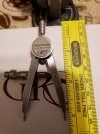alwayslearning2012
Member
This plate was an extra practice plate from October. It was an acetone transfer. The bottom I had to basically guess what it was telling me. So I improvised, albeit poorly. I feel that acetone transfers are okay for a light first pass. I can't really tell the width of the chip, or what the cut is doing with the ink mixed in. It's really hard to tell what I've created until I remove all that transfer.
I refaced the gravers I sharpened the other day. this was a 120. I'm trying this heel technique. There is some heel drag, but I'm happy that for the most part, it's not there. There are a few errant scratches, (I'll work on that).
Still in a constant battle relaxing the hand, and tend to force the graver to my will. Anyway, I welcome all comments.
AL12
I refaced the gravers I sharpened the other day. this was a 120. I'm trying this heel technique. There is some heel drag, but I'm happy that for the most part, it's not there. There are a few errant scratches, (I'll work on that).
Still in a constant battle relaxing the hand, and tend to force the graver to my will. Anyway, I welcome all comments.
AL12









